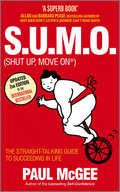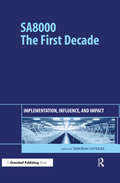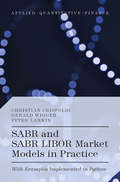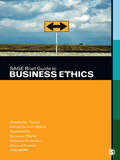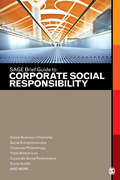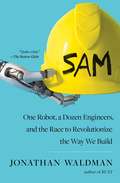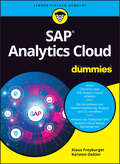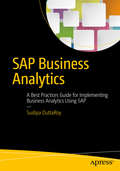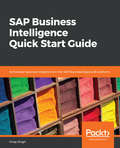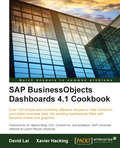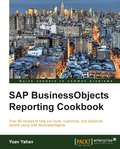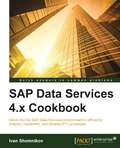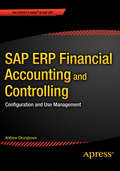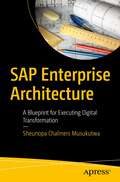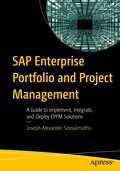- Table View
- List View
S.U.M.O (Shut Up, Move On): The Straight-Talking Guide to Succeeding in Life
by Paul McGeeThis is the long awaited second-edition of Paul McGee’s international bestselling personal development heavyweight S.U.M.O. Weighing in with humour, insight, practical tips and personal anecdotes, it’s a thought provoking – and possibly life–changing – read. S.U.M.O. has helped tens of thousands of people fulfil their potential, seize opportunities, succeed at work and respond to adverse situations with a positive attitude. Now comprehensively expanded and even more interactive, the 2nd edition, will help S.U.M.O. fans – and S.U.M.O. virgins – get even more out of this popular, straight-talking guide. S.U.M.O. stands for Shut Up, Move On. It's a phrase to say to ourselves (and sometimes others) when we are acting or thinking in a way that is hindering our ability to succeed. It doesn't necessarily mean 'get over it' or 'pull yourself together' (although there may be occasions when both responses are necessary). 'Shut Up' means stop what you're doing, take time out to reflect, let go of baggage and beliefs that hinder your potential. 'Move On' means tomorrow can be different from today, look for new possibilities, don't just think about it, take action. There are six S.U.M.O. principles that are designed to help you create and enjoy a brilliant life. If you are wrestling with life's challenges, these principles will help you do so more successfully. A brand new principle: E+R=O – Event + Response = Outcome. It's not just what happens to you but how you respond to it that shapes your life – you do have control. Change Your T–Shirt – take responsibility for your own life and don't be a victim. Develop Fruity Thinking – change your thinking and change your results. Hippo Time is OK – understand how setbacks affect you and how to recover from them. Remember the Beachball – increase your understanding and awareness of other people's world. Learn Latin – change comes through action not intention. Overcome the tendency to put things off. Ditch Doris Day – create your own future rather than leave it to chance. Forget the attitude 'que sera, sera, whatever will be, will be.' 'A superb book' Allan and Barbara Pease, bestselling authors of Why Men Don't Listen & Women Can't Read Maps 'The S.U.M.O. approach is powerful, simple and effective. Anyone who reads it is sure to look at themselves and the world differently as a result' Octavius black and Sebastian bailey, co-founders of The Mind Gym
SA Taxi: A Vehicle for Empowerment? (A)
by Nien-He Hsieh Dilyana Karadzhova Botha F. Christopher EaglinSA Taxi was a vertically integrated business that operated in South Africa's distinctive taxi industry. Despite being plagued by violence, informal structures, unsafe road practices and lack of government support, the taxi industry had grown to become South Africa's most common mode of public transport. SA Taxi was one of the largest companies entirely focused on serving the taxi industry. In addition to vehicle financing services, it offered insurance products, refurbishment services, and retail capabilities. SA Taxi served a mainly black-owned industry whose main participants-taxi owners, drivers, and commuters-had been historically disadvantaged. SA Taxi CEO Terry Kier understood that his company was already creating substantial impact for these constituents through financial inclusion, job creation and skills development but he knew that SA Taxi needed to do more to enhance its sustainability as well as that of the industry. By 2018, following multiple engagements with industry representatives, Kier saw an ownership deal that benefited the industry as SA Taxi's next strategic move. Although there was an alignment among the company's leadership on the need for and purpose of the deal, the transaction itself was far from clear. After consulting with internal and external stakeholders, Kier landed on three deal options. Kier and the company's founders needed to agree on the best path forward.
SA Taxi: A Vehicle for Empowerment? (B)
by Nien-He Hsieh Dilyana Karadzhova Botha F. Christopher EaglinSA Taxi was a vertically integrated business that operated in South Africa's distinctive taxi industry. Despite being plagued by violence, informal structures, unsafe road practices and lack of government support, the taxi industry had grown to become South Africa's most common mode of public transport. SA Taxi was one of the largest companies entirely focused on serving the taxi industry. In addition to vehicle financing services, it offered insurance products, refurbishment services, and retail capabilities. SA Taxi served a mainly black-owned industry whose main participants-taxi owners, drivers, and commuters-had been historically disadvantaged. SA Taxi CEO Terry Kier understood that his company was already creating substantial impact for these constituents through financial inclusion, job creation and skills development but he knew that SA Taxi needed to do more to enhance its sustainability as well as that of the industry. By 2018, following multiple engagements with industry representatives, Kier saw an ownership deal that benefited the industry as SA Taxi's next strategic move. Although there was an alignment among the company's leadership on the need for and purpose of the deal, the transaction itself was far from clear. After consulting with internal and external stakeholders, Kier landed on three deal options. Kier and the company's founders needed to agree on the best path forward.
SA8000: Implementation, Influence, and Impact
by Deborah LeipzigerThis is the first book in the field of corporate social responsibility to examine the progress of a standard over a ten-year period. Published in late 1997 and revised in 2001, the Social Accountability 8000 (SA8000) standard and verification system is a comprehensive tool aiming to assure humane workplaces throughout the supply chain. The SA8000 system includes: factory-level management system requirements for ongoing compliance and continual improvement; independent, expert verification of compliance by certification bodies; the involvement of all key stakeholders in the SA8000 system; and harnessing consumer and investor concern by helping to identify and support companies that are committed to assuring human rights in the workplace. As of 31 December 2007, nearly 700,000 workers were employed in 1,500 facilities certified to SA8000, in 65 countries and 67 industrial sectors.Ten years on, what has the impact of SA8000 been and how do its architects and users see it developing into the future? In this book, businesses, NGOs, academics and trade union leaders provide much-needed perspective on the lessons learned from SA8000 and set an agenda for the next decade. The book also provides context on the leading initiatives within the field of CSR (such as ISO 26000 and the Business for Social Compliance Initiative) and how they relate to SA8000. The book features case studies on the experiences of a wide range of companies, including Gucci, The GAP, Chiquita, TNT, Tata and Otto Versand, and on many of the most innovative programmes in the field of CSR, such as the Made-By label. Analysts from emerging economies provide valuable insights into how SA8000 has become a key tool in Brazil and India. The book addresses many of the key themes for corporate responsibility such as traceability, supply chain management and transparency.SA8000: The First Decade provides insights for company managers, NGOs, policy-makers and trade union leaders on how to implement a social standard and will be required reading for any manager seeking to implement SA8000 or any other code of conduct or standard for their suppliers.Deborah Leipziger is well known for her book The Corporate Responsibility Code Book, published in 2003 and considered to be one of the key reference books in the field of CSR. SA8000: The First Decade is an extension of Ms Leipziger's work over a 17-year career in the field of CSR, in which she has played a role in the development of many social standards, including SA8000 and the Ethical Trading Initiative, and advised many others.
SABR and SABR LIBOR Market Models in Practice: With Examples Implemented in Python (Applied Quantitative Finance)
by Peter Larkin Christian Crispoldi Gérald WiggerInterest rate traders have been using the SABR model to price vanilla products for more than a decade. However this model suffers however from a severe limitation: its inability to value exotic products. A term structure model à la LIBOR Market Model (LMM) is often employed to value these more complex derivatives, however the LMM is unable to capture the volatility smile. A joint SABR LIBOR Market Model is the natural evolution towards a consistent pricing of vanilla and exotic products. Knowledge of these models is essential to all aspiring interest rate quants, traders and risk managers, as well an understanding of their failings and alternatives. SABR and SABR Libor Market Models in Practice is an accessible guide to modern interest rate modelling. Rather than covering an array of models which are seldom used in practice, it focuses on the SABR model, the market standard for vanilla products, the LIBOR Market Model, the most commonly used model for exotic products and the extended SABR LIBOR Market Model. The book takes a hands-on approach, demonstrating simply how to implement and work with these models in a market setting. It bridges the gap between the understanding of the models from a conceptual and mathematical perspective and the actual implementation by supplementing the interest rate theory with modelling specific, practical code examples written in Python.
SADAFCO
by David J. ArnoldSADAFCO has long enjoyed a dominant position in the milk and ice cream markets in Saudi Arabia. In the mid-1990s, this dominance was under threat as Nestle, Unilever, and Mars all entered the ice cream market. The case outlines the Saudi Arabian ice cream wars.
SAFETY IS SEGURIDAD: A Workshop Summary
by Committee on Communicating Occupational Safety Health Information to Spanish-speaking WorkersThe National Academies Press (NAP)--publisher for the National Academies--publishes more than 200 books a year offering the most authoritative views, definitive information, and groundbreaking recommendations on a wide range of topics in science, engineering, and health. Our books are unique in that they are authored by the nation's leading experts in every scientific field.
SAGE Brief Guide to Business Ethics
by Sage PublicationsThis guide to business ethics provides key terms and concepts related to business ethics in a short, easy-to-use format. It provides objective coverage of theories, corporate social responsibility, human resources issues, consumer protection, and ethical issues in marketing and advertising. It is an ideal supplement for business ethics courses or as a reference for students and practitioners who would like to learn more about the basics of business ethics.
SAGE Brief Guide to Corporate Social Responsibility
by Sage PublicationsThis guide to corporate social responsibility (CSR) provides discussion of key concepts in a short, easy-to-use format. It is divided into sections on key terms, the global stage, corporate governance, corporate social responsiveness, public relations and philanthropy, and implications for corporate financial performance. It is an ideal supplement for business courses or as a reference for students and practitioners who would like to learn more about the basics of CSR.
SAGE Brief Guide to Marketing Ethics
by Sage PublicationsMarketing ethics is the systematic study of how moral standards are applied to marketing decisions, behaviors, and institutions. This guide to marketing ethics provides all the key terms and concepts in a short, easy-to-use format, with each entry written by a scholar from the field of business or marketing ethics. This essential companion can be used in a number of marketing courses and will be a valuable reference for practitioners.
SAIF: May 2004
by G. Felda Hardymon Ann LeamonThe Softbank Asia Infrastructure Fund (SAIF) team has just learned that the price at which its portfolio company, the Chinese gaming firm Shanda, was planning to go public must be reduced. As a result, the partners think through the entire genesis of the deal and the differences between doing venture capital in China and in the United States. Illustrates the intricacies of strategic venture investing.
SAM: One Robot, a Dozen Engineers, and the Race to Revolutionize the Way We Build
by Jonathan WaldmanA true story of innovation that &“reads like a movie&” (Seth Godin), centered on a scrappy team of engineers—far from the Silicon Valley limelight—and their quest to revolutionize the traditional trade of masonry by building a robot that can lay bricks.Humans have landed men on the moon, programmed cars to drive themselves, and put the knowledge of our entire civilization in your back pocket. But no one—from MIT nerds to Army Corps engineers—has ever built a robot that can lay bricks as well as a mason. Unlike the controlled conditions of a factory line, where robots are now ubiquitous, no two construction sites are alike, and a day&’s work involves countless variables—bricks that range in size and quality, temperamental mortar mixes, uneven terrain, fickle weather, and moody foremen. Twenty-five years ago, on a challenging construction job in Syracuse, architect Nate Podkaminer had a vision of a future full of efficient, automated machines that freed bricklayers from the repetitive, toilsome burden of lifting, in bricks, the equivalent of a Ford truck every few days. Offhandedly, he mentioned the idea to his daughter&’s boyfriend, and after some inspired scheming, the architect and engineer—soon to be in-laws—cofounded a humble start-up called Construction Robotics. Working out of a small trailer, they recruited a boldly unconventional team of engineers to build the Semi-Automated Mason: SAM. In classic American tradition, a small, unlikely, and eccentric family-run start-up sought to reimagine the behemoth $1 trillion construction industry—the second biggest industry in America—in bootstrap fashion. In the tradition of Tracy Kidder&’s The Soul of a New Machine, SAM unfolds as an engineering drama, full of trials and setbacks, heated showdowns between meticulous scientists and brash bricklayers (and their even more opinionated union), and hard-earned milestone achievements. Jonathan Waldman, acclaimed author of Rust, masterfully &“reveals a world that surrounds us but mostly eludes our notice&” (The Boston Globe).
SAP 2014: Reaching for the Cloud
by Marco Iansiti Karim R. Lakhani Noah FisherIn May 2014, Bill McDermott will become the sole CEO of SAP AG, the world leader in the Enterprise Resource Planning (ERP) field. The case occurs in January 2014 at SAP's investors meeting, at a time when the company's stock is near record high. A 2010 strategy committed the company to a transition to cloud computing. The main driver behind this transition was the development of SAP HANA, an in-memory computing technology that combined database, data processing, and application platform functionality. Ownership of cloud infrastructure was a key question. SAP could build, own, and operate its own data centers, or partner to locate SAP HANA and other products with other cloud infrastructure providers, such as Amazon, Microsoft, or IBM. McDermott also had to make decisions around the organization and leadership of the company's cloud efforts.
SAP 2014: Reaching for the Cloud
by Marco Iansiti Karim R. Lakhani Noah FisherIn May 2014, Bill McDermott will become the sole CEO of SAP AG, the world leader in the Enterprise Resource Planning (ERP) field. The case occurs in January 2014 at SAP's investors meeting, at a time when the company's stock is near record high. A 2010 strategy committed the company to a transition to cloud computing. The main driver behind this transition was the development of SAP HANA, an in-memory computing technology that combined database, data processing, and application platform functionality. Ownership of cloud infrastructure was a key question. SAP could build, own, and operate its own data centers, or partner to locate SAP HANA and other products with other cloud infrastructure providers, such as Amazon, Microsoft, or IBM. McDermott also had to make decisions around the organization and leadership of the company's cloud efforts.
SAP AG: Orchestrating the Ecosystem
by Marco Iansiti Karim R. LakhaniBusiness ecosystems require careful orchestration and strategic choices regarding make/buy/partner decisions and membership access. This case examines the strategic and technological issues related to managing SAP's thriving ecosystem of user communities, software vendors, integration partners and technology providers. It details how the ecosystem gets developed and the challenges in meeting the needs of the internal organization, large partners, and small up and coming firms. SAP executives, in this case, have to make a decision if a relatively small startup firm should be elevated to the highest strategic partnership level, normally reserved for very large firms.
SAP AG: Orchestrating the Ecosystem
by Marco Iansiti Karim R. LakhaniBusiness ecosystems require careful orchestration and strategic choices regarding make/buy/partner decisions and membership access. This case examines the strategic and technological issues related to managing SAP's thriving ecosystem of user communities, software vendors, integration partners and technology providers. It details how the ecosystem gets developed and the challenges in meeting the needs of the internal organization, large partners, and small up and coming firms. SAP executives, in this case, have to make a decision if a relatively small startup firm should be elevated to the highest strategic partnership level, normally reserved for very large firms.
SAP Analytics Cloud für Dummies (Für Dummies)
by Karsten Oehler Klaus FreyburgerDas ist alles in der Cloud Dieses Buch ist Ihnen eine große Hilfe, wenn Sie sich mit SAP Analytics Cloud beschäftigen wollen oder müssen. Die Fachleute Klaus Freyburger und Karsten Oehler erklären Ihnen die Grundideen der SAP Analytics Cloud. Sie erläutern das Wichtigste zum Navigieren in der Anwendung, zur Datenmodellierung und -integration, zu Stories und Reporting, Planung, Administration und vielem mehr. Anhand zahlreicher Fallstudien werden Sie Schritt für Schritt durch die wesentlichen Konzepte geführt und können diese im System umsetzen. Sie erfahren Welche typischen Anforderungen an Planung und Analyse gestellt werden Wie Sie mit wenigen Mitteln gute Visualisierungen erzeugen Wie Sie eine unternehmensweite Simulation umsetzen Wie Sie mit Scripting Berichte individualisieren
SAP Business Analytics
by Sudipa DuttaroyFocus on SAP business analytics business gains, key features, and implementation. The book includes example implementations of SAP business analytics, the challenges faced, and the solutions implemented. SAP Business Analytics explains both the strategy and technical implementation for gathering and analyzing all the information pertaining to an organization. Key features of the book are: A 360-degree view of an organization's data and the methods to gather and analyze that data The strategies that need to be in place to gather relevant data from disparate systems Details about the SAP business analytics suite of products The technical implementations used to gather data from disparate systems such as ERP and CRM Real business cases as examples Analytics is the driving force in today's business, be it healthcare, marketing, telecommunications, or retail and hence the most vital part of any organization's strategy. What You'll Learn Gain an understanding of business analytics in general Absorb the technical details of the SAP business analytics suite of products Discover the challenges faced during an enterprise-level analytics project implementation Learn the key points to be kept in mind during the technical implementation of an SAP business analytics project Who This Book Is For Analytics strategists, BI managers, BI architects, business analysts, and BI developers.
SAP Business Intelligence Quick Start Guide: Actionable business insights from the SAP BusinessObjects BI platform
by Vinay SinghDesigning and deploying solutions using the SAP BusinessObjects Business Intelligence platform 4.2.Key FeaturesGet up and running with the SAP BusinessObjects Business Intelligence platformPerform effective data analysis and visualization for actionable insightsEnhance your BI strategy by creating different types of reports and dashboards using SAP BusinessObjectsBook DescriptionThe SAP BusinessObjects Business Intelligence platform is a powerful reporting and analysis tool. This book is the ideal introduction to the SAP BusinessObjects Business Intelligence platform, introducing you to its data visualization, visual analytics, reporting, and dashboarding capabilities.The book starts with an overview of the BI platform and various data sources for reporting. Then, we move on to looking at data visualization, analysis, reporting, and analytics using BusinessObjects Business Intelligence tools. You will learn about the features associated with reporting, scheduling, and distribution and learn how to deploy the platform. Toward the end, you will learn about the strategies and factors that should be considered during deployment.By the end, you will be confident working with the SAP BusinessObjects Business Intelligence platform to deliver better insights for more effective decision making.What you will learnWork with various tools to create interactive data visualization and analysis Query, report, and analyze with SAP Business Objects Web IntelligenceCreate a report in SAP Crystal Reports for EnterpriseVisualize and manipulate data using an SAP Lumira StoryboardDeep dive into the workings of the SAP predictive analytics toolDeploy and configure SAP BO Intelligence platform 4.2Who this book is forThis book is for Business Intelligence professionals and existing SAP ecosystem users who want to perform effective Business Intelligence using SAP BusinessObjects.
SAP BusinessObjects Dashboards 4.0 Cookbook
by David Lai Xavier HackingThis guide to SAP BusinessObjects Dashboards 4.0 (formerly Xcelsius )is a cookbook packed full of practical recipes written in a clear, concise manner with annotated examples to empower readers to quickly accomplish specific dashboard tasks. If you are a developer with a good command and knowledge of creating dashboards, but are not yet an advanced Dashboard Design user, then this is the perfect book for you. You should have a good working knowledge of Microsoft Excel as well as knowledge of basic dashboard practices, though experience of Dashboard Design as a specific dashboard tool is not essential.
SAP BusinessObjects Reporting Cookbook
by Yoav YahavIf you are a business analyst, BI developer, or an IT professional who wants to learn the A to Z of how to work with Web Intelligence reporting tools and different types of data, then this book is for you. The only thing you need is a basic understanding of what Business Intelligence is and data concepts.
SAP Data Services 4.x Cookbook
by Ivan ShomnikovDelve into the SAP Data Services environment to efficiently prepare, implement, and develop ETL processes About This Book * Install and configure the SAP Data Services environment * Develop ETL techniques in the Data Services environment * Implement real-life examples of Data Services uses through step-by-step instructions to perform specific ETL development tasks Who This Book Is For This book is for IT technical engineers who want to get familiar with the EIM solutions provided by SAP for ETL development and data quality management. The book requires familiarity with basic programming concepts and basic knowledge of the SQL language. What You Will Learn * Install, configure, and administer the SAP Data Services components * Run through the ETL design basics * Maximize the performance of your ETL with the advanced patterns in Data Services * Extract methods from various databases and systems * Get familiar with the transformation methods available in SAP Data Services * Load methods into various databases and systems * Code with the Data Services scripting language * Validate and cleanse your data, applying the Data quality methods of the Information Steward In Detail Want to cost effectively deliver trusted information to all of your crucial business functions? SAP Data Services delivers one enterprise-class solution for data integration, data quality, data profiling, and text data processing. It boosts productivity with a single solution for data quality and data integration. SAP Data Services also enables you to move, improve, govern, and unlock big data. This book will lead you through the SAP Data Services environment to efficiently develop ETL processes. To begin with, you'll learn to install, configure, and prepare the ETL development environment. You will get familiarized with the concepts of developing ETL processes with SAP Data Services. Starting from smallest unit of work- the data flow, the chapters will lead you to the highest organizational unit--the Data Services job, revealing the advanced techniques of ETL design. You will learn to import XML files by creating and implementing real-time jobs. It will then guide you through the ETL development patterns that enable the most effective performance when extracting, transforming, and loading data. You will also find out how to create validation functions and transforms. Finally, the book will show you the benefits of data quality management with the help of another SAP solution--Information Steward. Style and approach This book is an easy-to-follow guide with step-by-step instructions to perform specific ETL development tasks.
SAP ERP Financial Accounting and Controlling
by Andrew OkungbowaSAP ERP modules are notoriously hard to configure and use effectively without a lot of practice and experience. But as SAP ERP Financial Accounting and Controlling: Configuration and Use Management shows, it doesn''t have to be so difficult. The book takes a systematic approach that leads SAP Financial Accounting and Controlling (FICO) users step by step through configuring and using all the program''s facets. This approach makes configuration complexities manageable. The book''s author--SAP expert, trainer, and accountant Andrew Okungbowa--ensures that both you and your end users are up and running quickly and confidently with FICO. He also provides sound and tested procedures that ensure your implementation works without error. SAP ERP Financial Accounting and Controlling: Configuration and Use Management is in fact the most comprehensive and easy-to-follow SAP FICO configuration book in the market. It incorporates a hands-on approach, with hundreds of screen shots and practical examples, that allows a person without prior configuration training to make SAP FICO ready for use in the enterprise. You''ll find that you don''t need to be a rocket scientist to grasp the concepts explained and apply them to your work--even when the finances are complicated, such as with the ins and outs of taxes, currency conversions, or special general ledger entries such as down payments or bills of exchange. Providing an in-depth coverage of both configuration and end user procedures, the book covers most aspects of the SAP FICO certification syllabus--SAP''s view of the module''s key tasks and procedures--including: Configuring and using the general ledger and accounts payable and receivable screens Configuring and completing closing procedures, asset accounting, and financial reporting Configuring global settings and enterprise variables Accounting for both profit and cost centers Creating a house bank Integrating FICO with other SAP modules Taking a jargon-free tone and providing an abundance of examples, Andrew Okungbowa provides a clear understanding of configuration techniques and the breadth of functionalities encompassed by SAP FICO. And as an accountant, Okungbowa understands the needs of end users as well as of those answering to the CIO. What you''ll learn How to configure SAP FICO like a pro How to master core aspects of SAP Financial Accounting and Controlling How to integrate SAP FICO with other SAP Modules A thorough hands-on overview of IMG (Implementation Guide) and Easy Access (user point of entry into SAP) Knowledge gained from real-world practical examples and case studies How to explain the functionalities of SAP FICO to others Who this book is for FICO consultants, enterprise IT implementers and support personnel, accountants, trainers, and developers. While not aimed at beginners per se, beginners can use the book to do a complete configuration of SAP FICO. Table of Contents 1. Customizing Organizational Structure in SAP ERP 2. Defining the Chart of Accounts 3. Document Control 4. Defining Tolerance Groups for G/L Accounts and Employees 5. Creating a General Ledger (G/L) 6. Clearing Open Items 7. Maintaining Currency Types and Currency Pairs 8. Defining Adjustment Accounts for GR/IR Clearing 9. Defining the House Bank 10. Defining Tax on Sales and Purchases 11. Customizing a Cash Journal 12. Financial Statement Versions (FSV) 13. Integration of FI with Other SAP ERP Modules 14. Defining Accounts Receivable and Accounts Payable 15. Defining the Dunning Procedure and Correspondence 16. Customizing Special G/L Transactions 17. Easy Access 18. Controlling 19. New General Ledger Appendix A: Some Useful G/L Accounts Appendix B: Some Useful Transaction Codes
SAP Enterprise Architecture: A Blueprint for Executing Digital Transformation
by Sheunopa Chalmers MusukutwaDoes digital transformation ever stop? The answer is a resounding “no" and this book guides you in developing an SAP enterprise architecture that prepares you for constant technology changes.The book introduces enterprise architecture, the role it plays in executing successful business strategy, and its application in SAP. A detailed step-by-step guide teaches you how to utilize SAP Enterprise Architecture Designer to model the four key areas: business, data, landscape, and requirements. Executives will gain insight into the considerations that will aid them in building their digital transformation road map while remaining agile to adapt to unforeseen circumstances. and adapting to the new normal. SAP partners and consultants will find their place in SAP’s future.By the end of this book, you will learn what SAP enterprise architecture is and how to develop it along with its best practices.You Will UnderstandThe fundamentals of enterprise architectureSAP enterprise architectureHow SAP Enterprise Architecture Designer helps your enterpriseBusiness, information, and infrastructure architecture Enterprise architecture best practicesHow enterprise architecture can prepare your business for the futureWho This Book Is ForExecutives who currently run SAP implementations or are considering SAP implementations, SAP partners and consultants along with aspiring SAP consultants, and technology enthusiasts interested in understanding and articulating IT and business alignment through enterprise architecture
SAP Enterprise Portfolio and Project Management: A Guide to Implement, Integrate, and Deploy EPPM Solutions
by Joseph Alexander SoosaimuthuLearn the fundamentals of SAP Enterprise Project and Portfolio management Project Systems (PS), Portfolio and Project Management (PPM) and Commercial Project Management (CPM) and their integration with other SAP modules. This book covers various business scenarios from different industries including the public sector, engineering and construction, professional services, telecom, mining, chemical, and pharmaceutical. Author Joseph Alexander Soosaimuthu will help you understand common business challenges and pain areas faced in portfolio, program and project management, and will provide suitable recommendations to overcome these challenges. This book not only suggests solutions within SAP, but also provides workarounds or integrations with third-party tools based on various Industry-specific business requirements. SAP Portfolio and Project Management addresses commonly asked questions regarding SAP EPPM implementation and deployment, and conveys a framework to facilitate engagement and discussion with key stakeholders. This provides coverage of SAP on-premise solutions with ECC 6.08 and SAP PPM 6.1 deployed on the same client, as well as S/4 HANA On-Premise 2020 with integration to BPC and BI/W systems. Interface with other third-party schedule management, estimation, costing and forecasting applications are also covered in this book. After completing SAP Portfolio and Project Management, you will be able to implement SAP Enterprise Portfolio and Project Management based on industry best practices. For your reference, you’ll also gain a list of development objects and a functionality list by Industry, and a Fiori apps list for Enterprise Portfolio and Project Management (EPPM). What You Will Learn Understand the fundamentals of project, program and portfolio management within SAP EPPMMaster the art of project forecasting and scheduling integrations with other SAP modulesGain knowledge of the different interface options for scheduling, estimation, costing and forecasting third party applicationsLearn EPPM industry best practices, and how to address industry-specific business challenges Leverage operational and strategic reporting within EPPM Who This Book For Functional consultants and business analysts who are involved in SAP EPPM (PS, PPM and CPM) deployment and clients who are interested and are in the process of having SAP EPPM deployed for their Enterprise.
